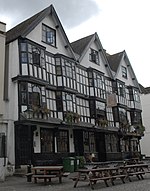Redcliffe Bridge, Bristol

Redcliffe Bridge is a bascule bridge over the floating harbour in Bristol, England. The bridge was built in 1938 and rebuilt in 1942 after being damaged by bombing during the Second World War.The bridge connects The Grove and Welsh Back, on the western side of the harbour, with Redcliffe to the east. It is the furthest upstream of the opening bridges across the harbour. The next bridge upstream, Bristol Bridge, is a fixed bridge that marks the limit of navigation for any vessel unable to pass beneath its arches.From 1882 until the building of Redcliffe Bridge, a ferry connected The Grove with Guinea Street.The bridge is currently undergoing maintenance and as a result, is closed to all motorised and pedestrian traffic.
Excerpt from the Wikipedia article Redcliffe Bridge, Bristol (License: CC BY-SA 3.0, Authors, Images).Redcliffe Bridge, Bristol
Redcliffe Way, Bristol Redcliffe
Geographical coordinates (GPS) Address External links Nearby Places Show on map
Geographical coordinates (GPS)
| Latitude | Longitude |
|---|---|
| N 51.4495 ° | E -2.5919 ° |
Address
Redcliffe Bascule Bridge
Redcliffe Way
BS1 4AN Bristol, Redcliffe
England, United Kingdom
Open on Google Maps










